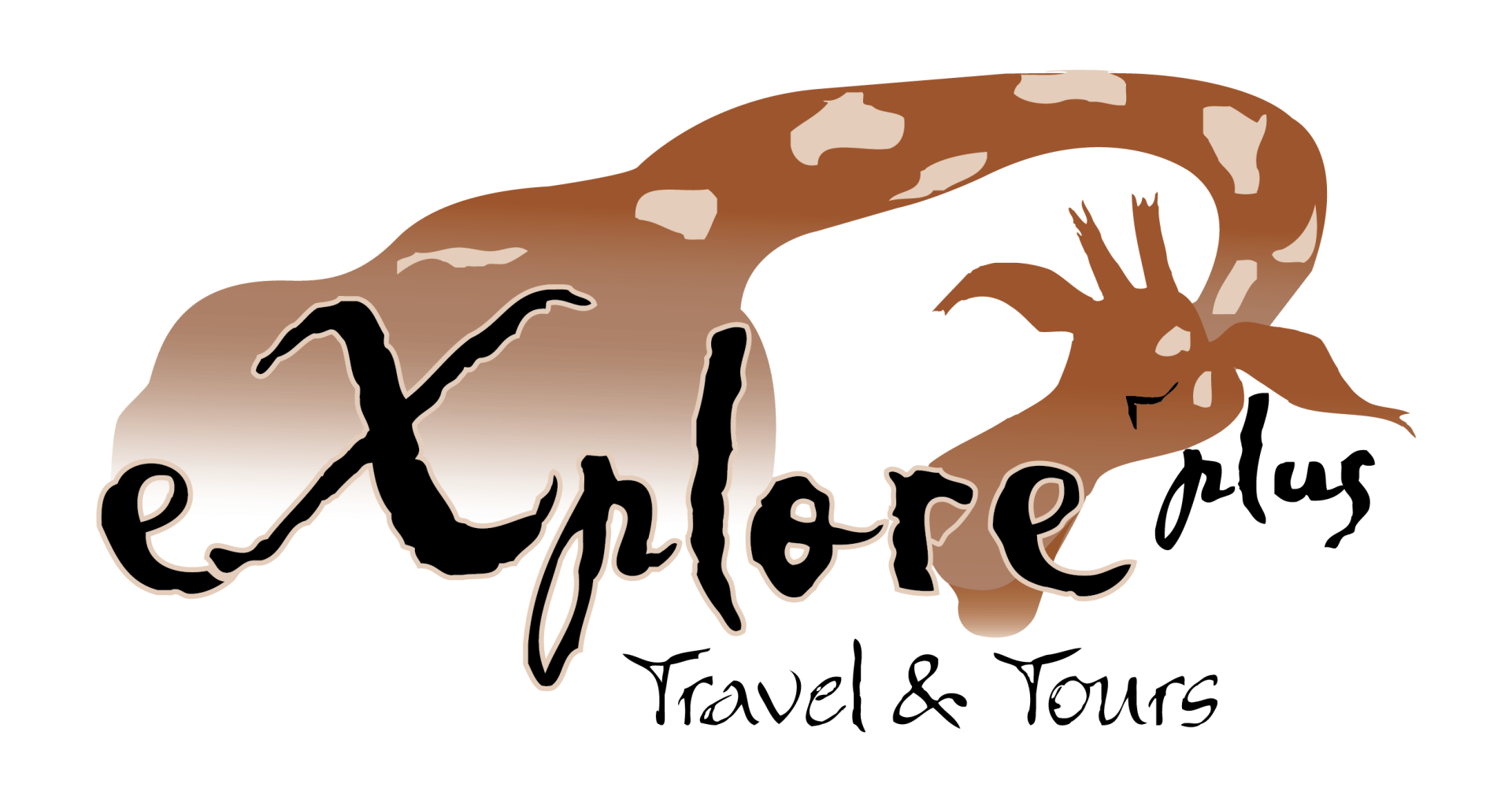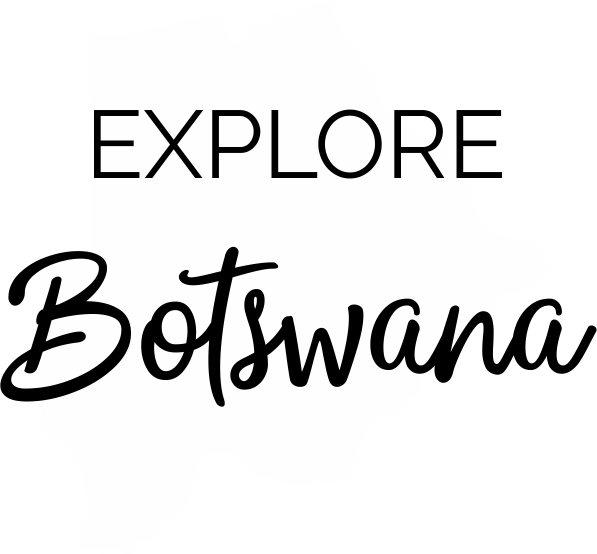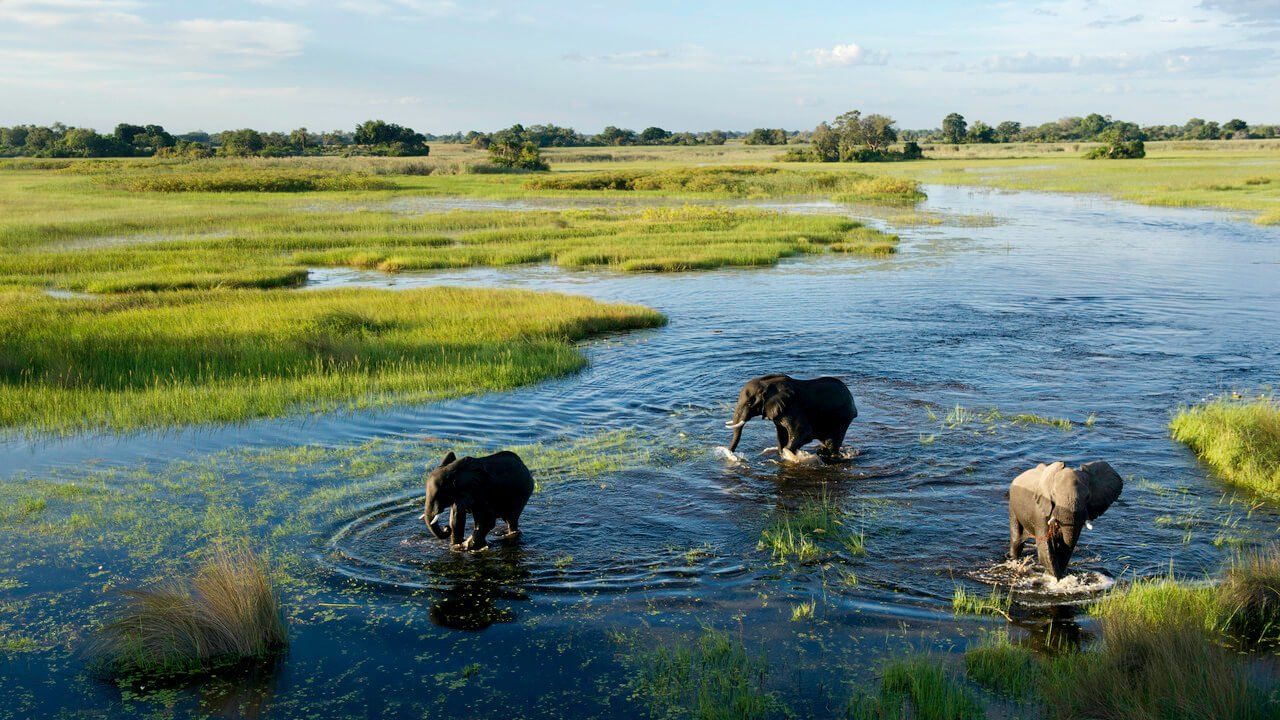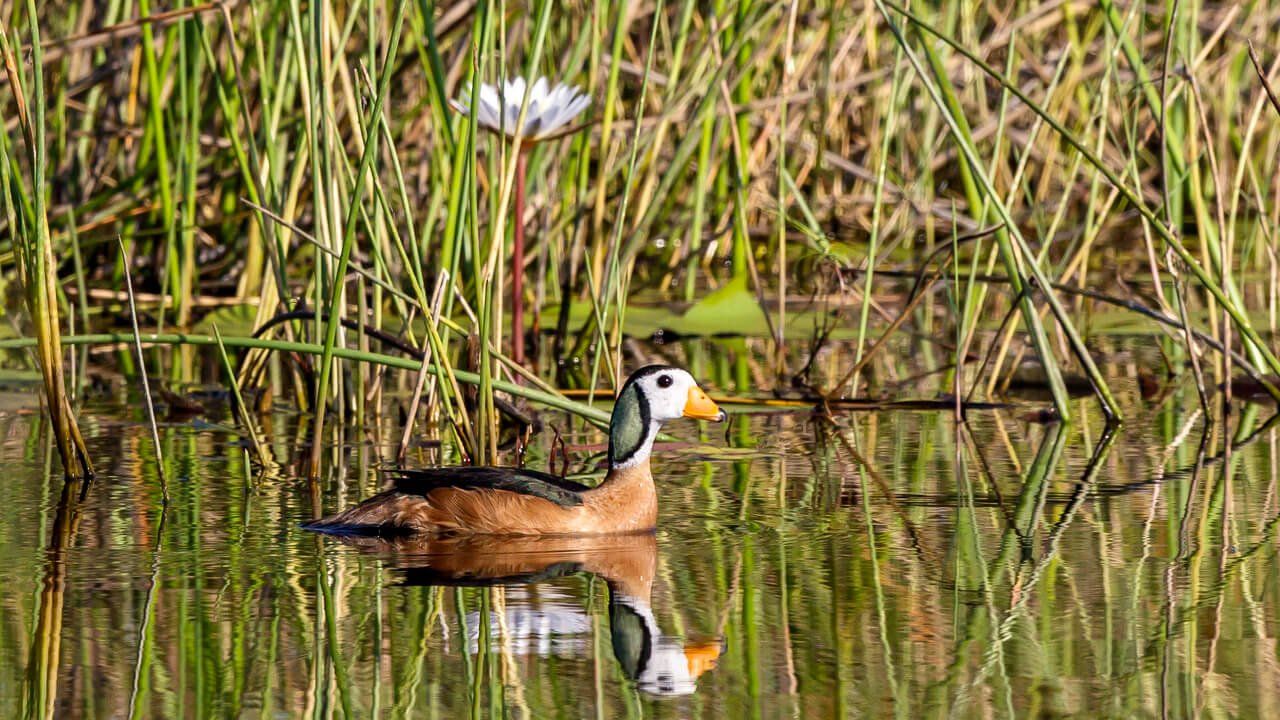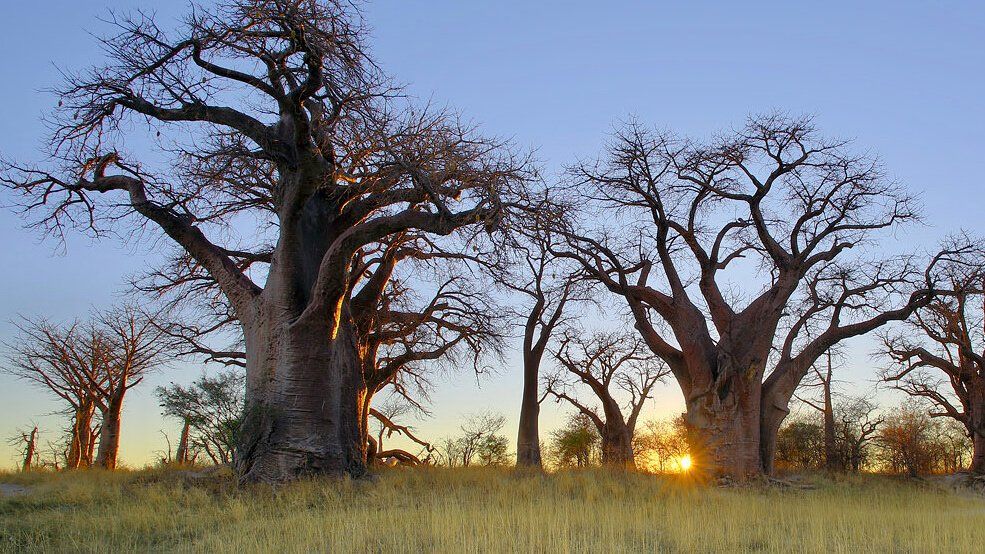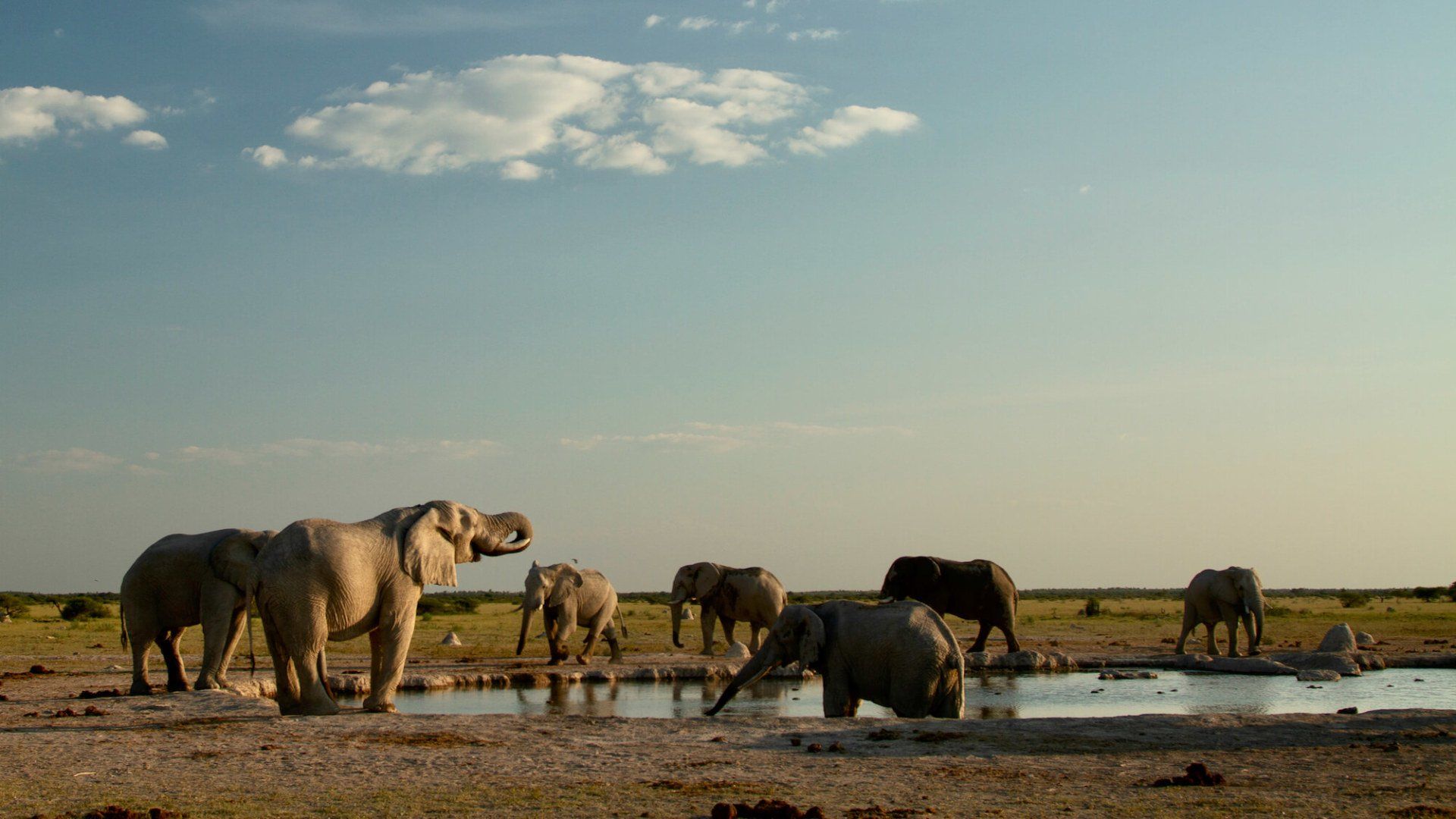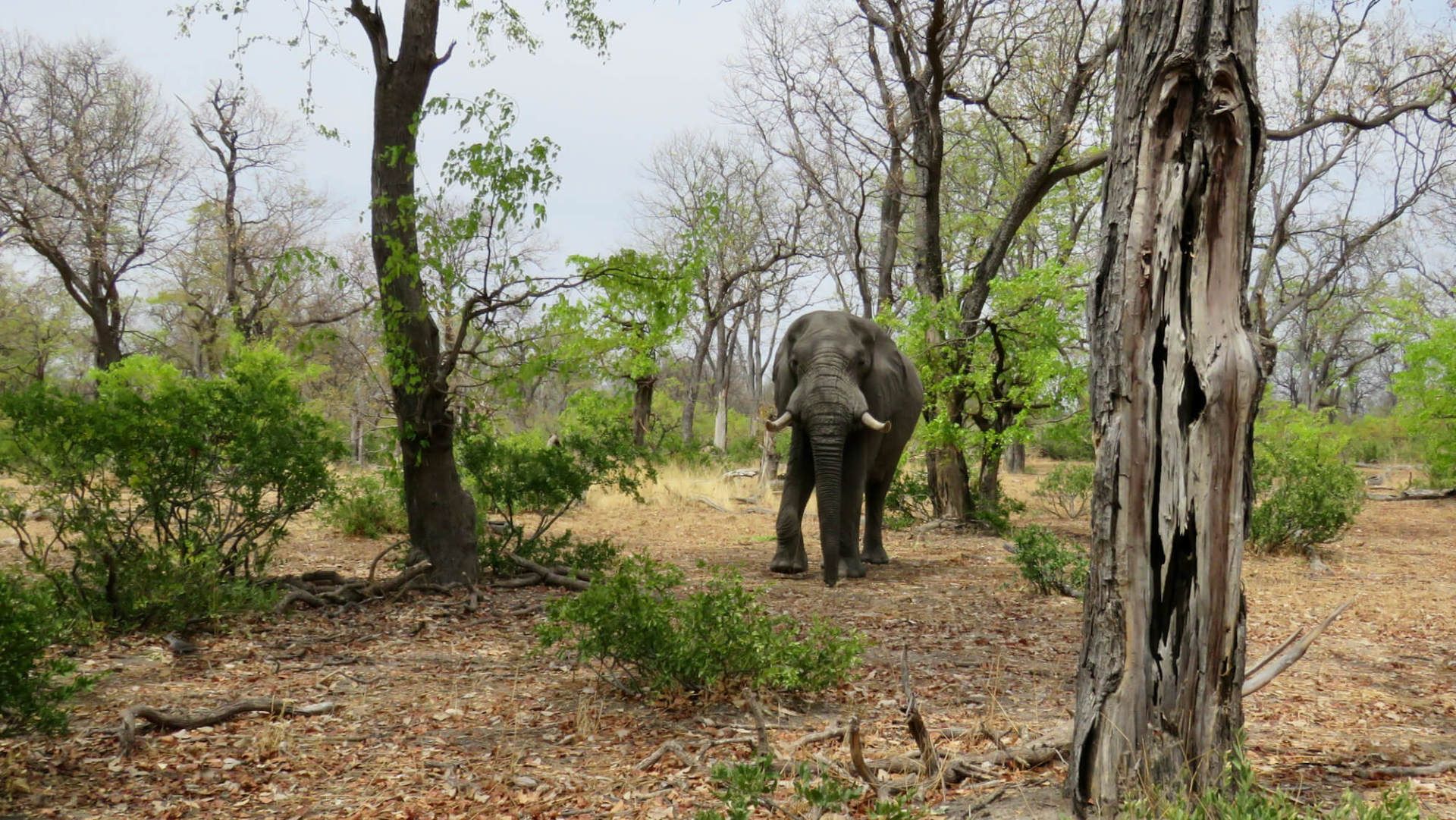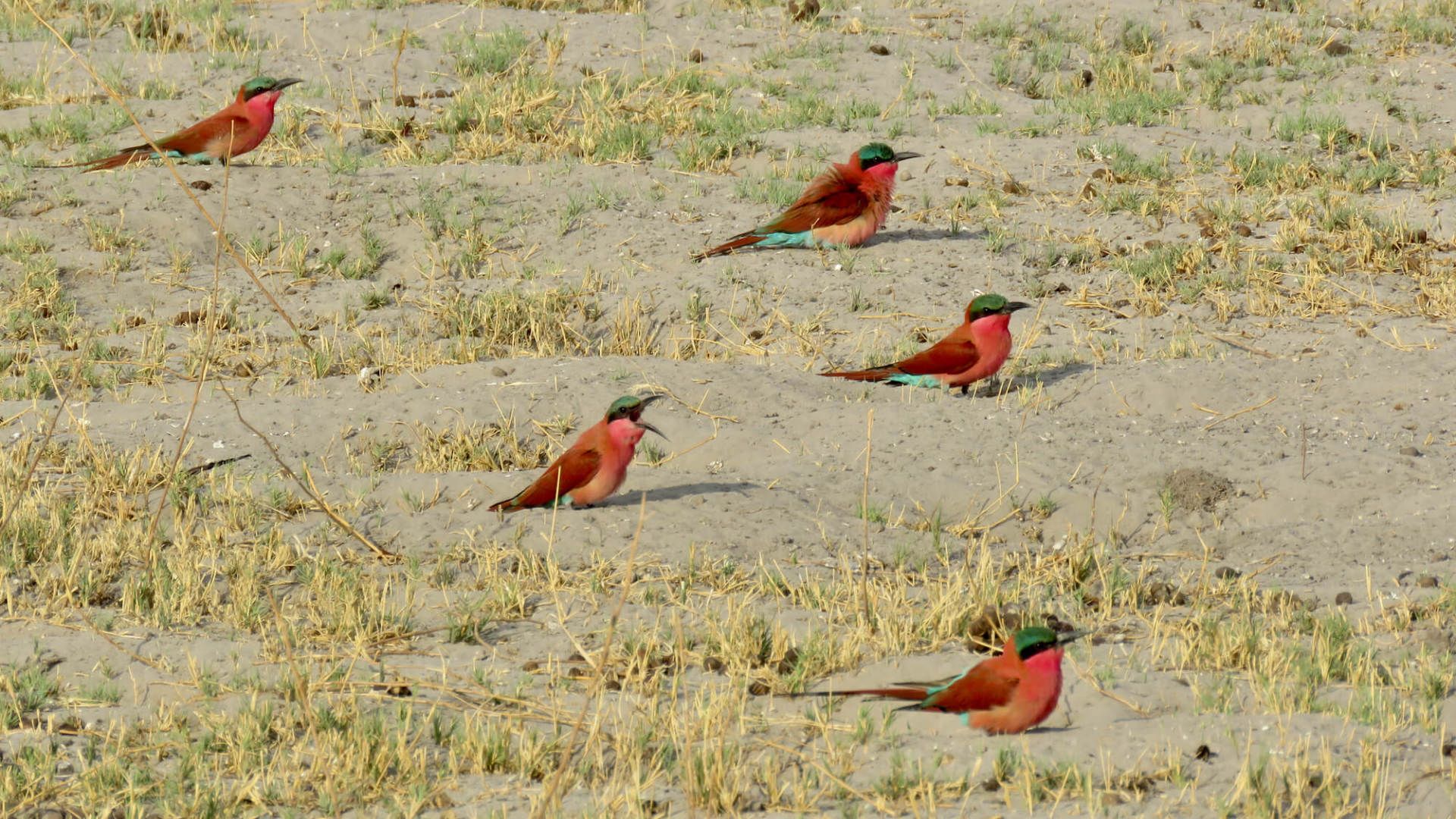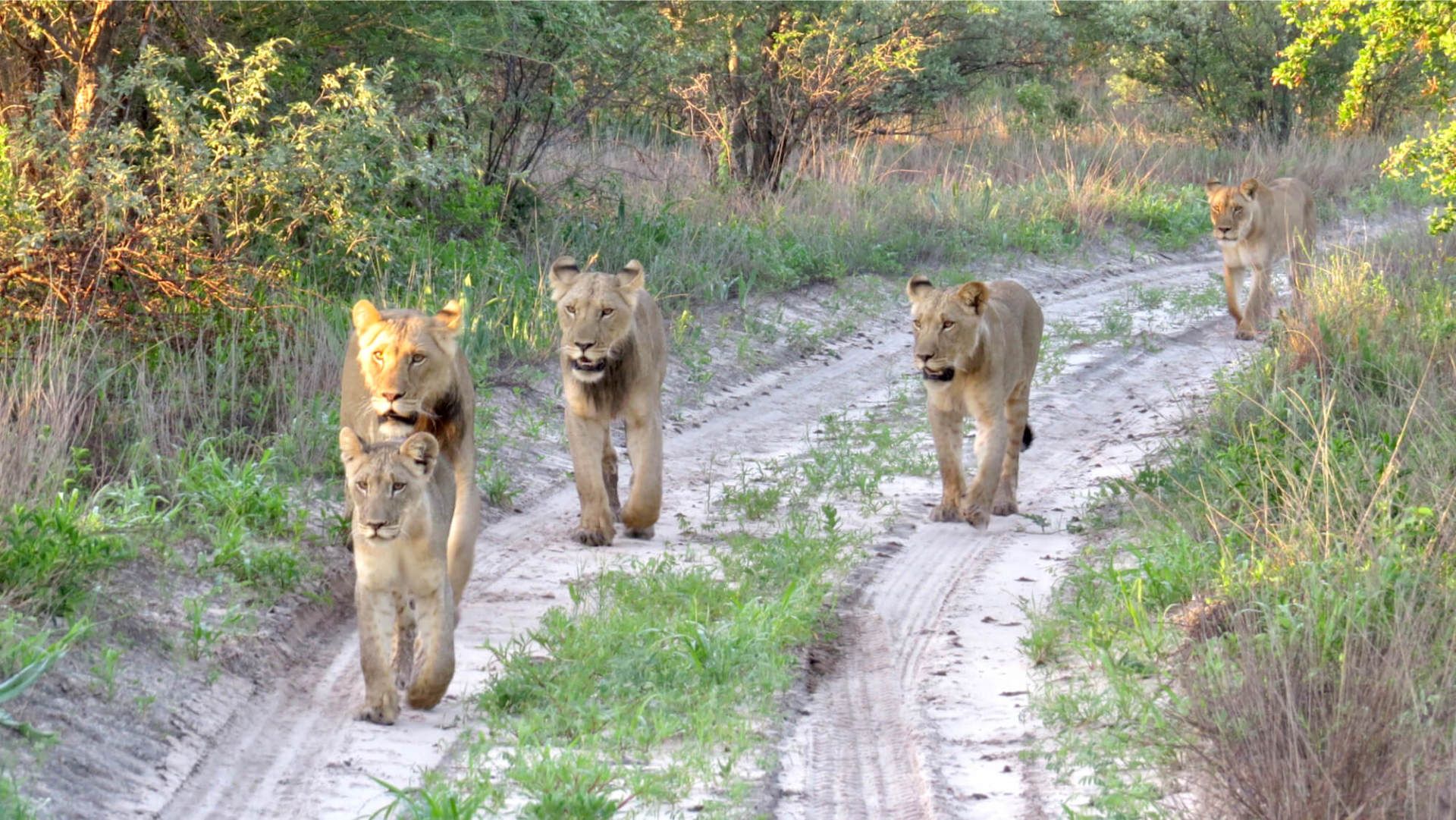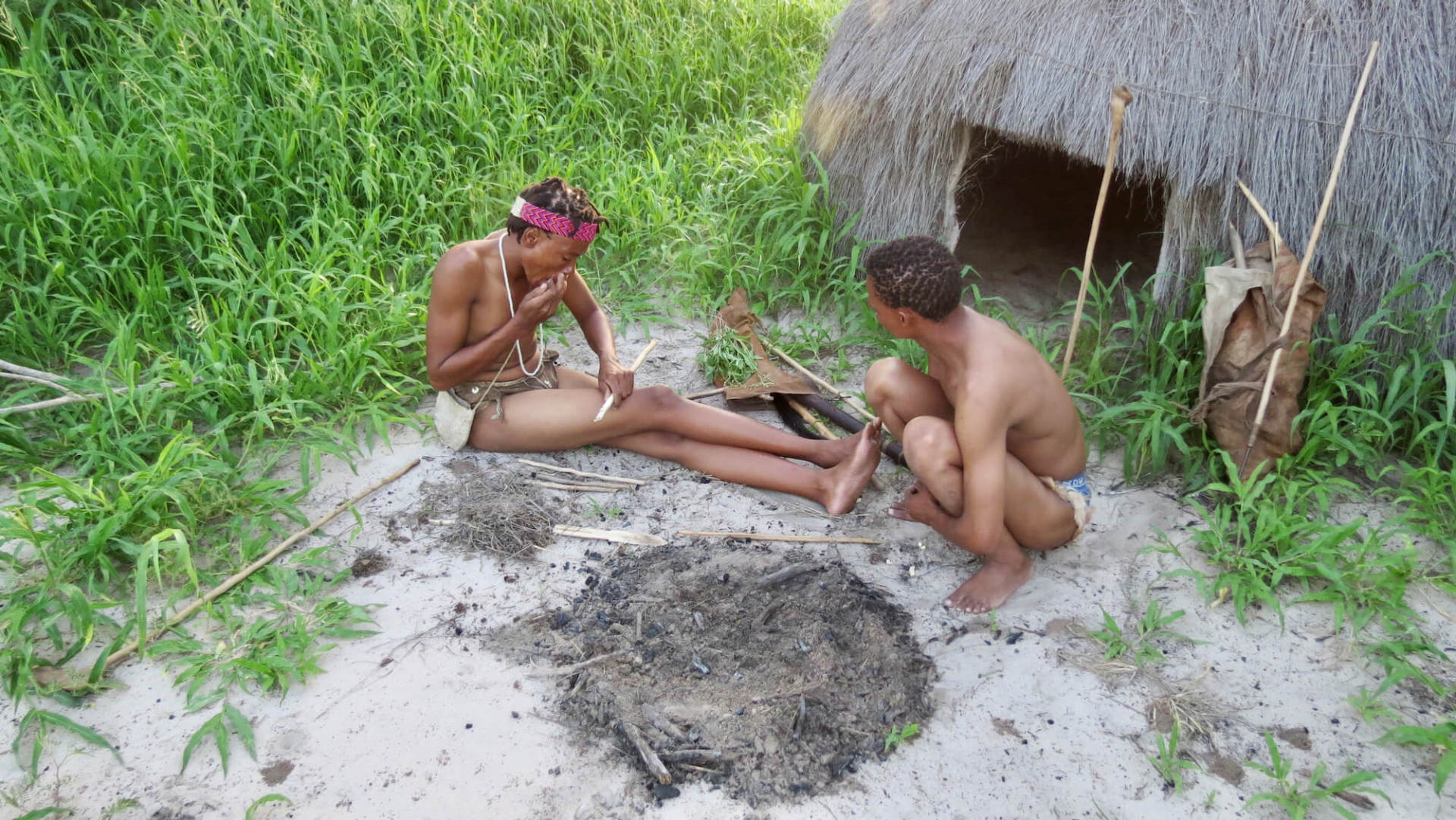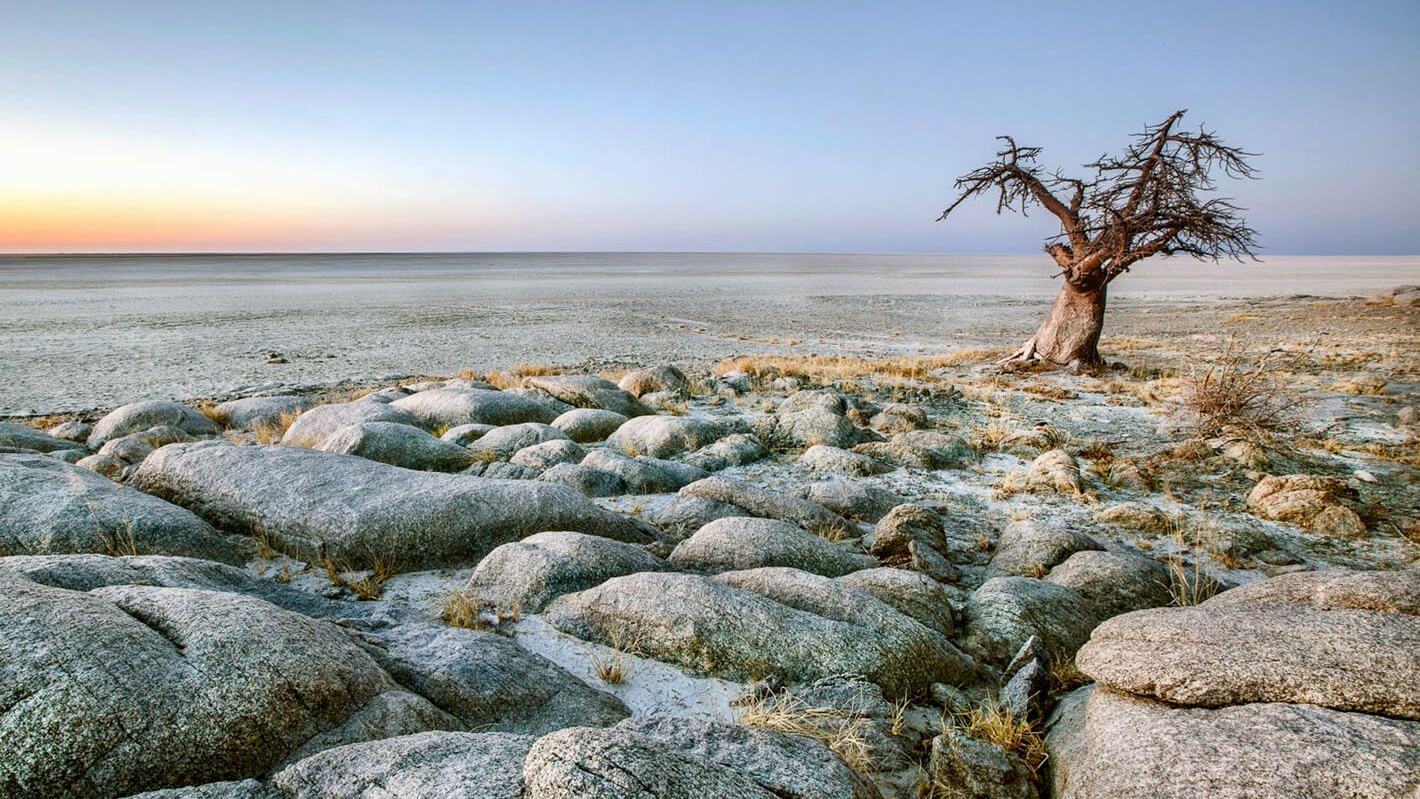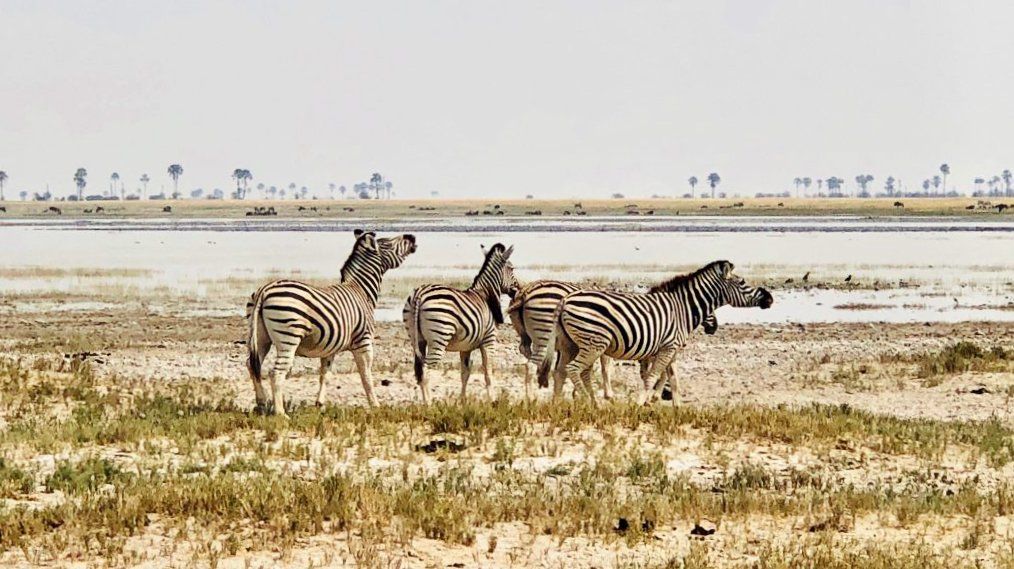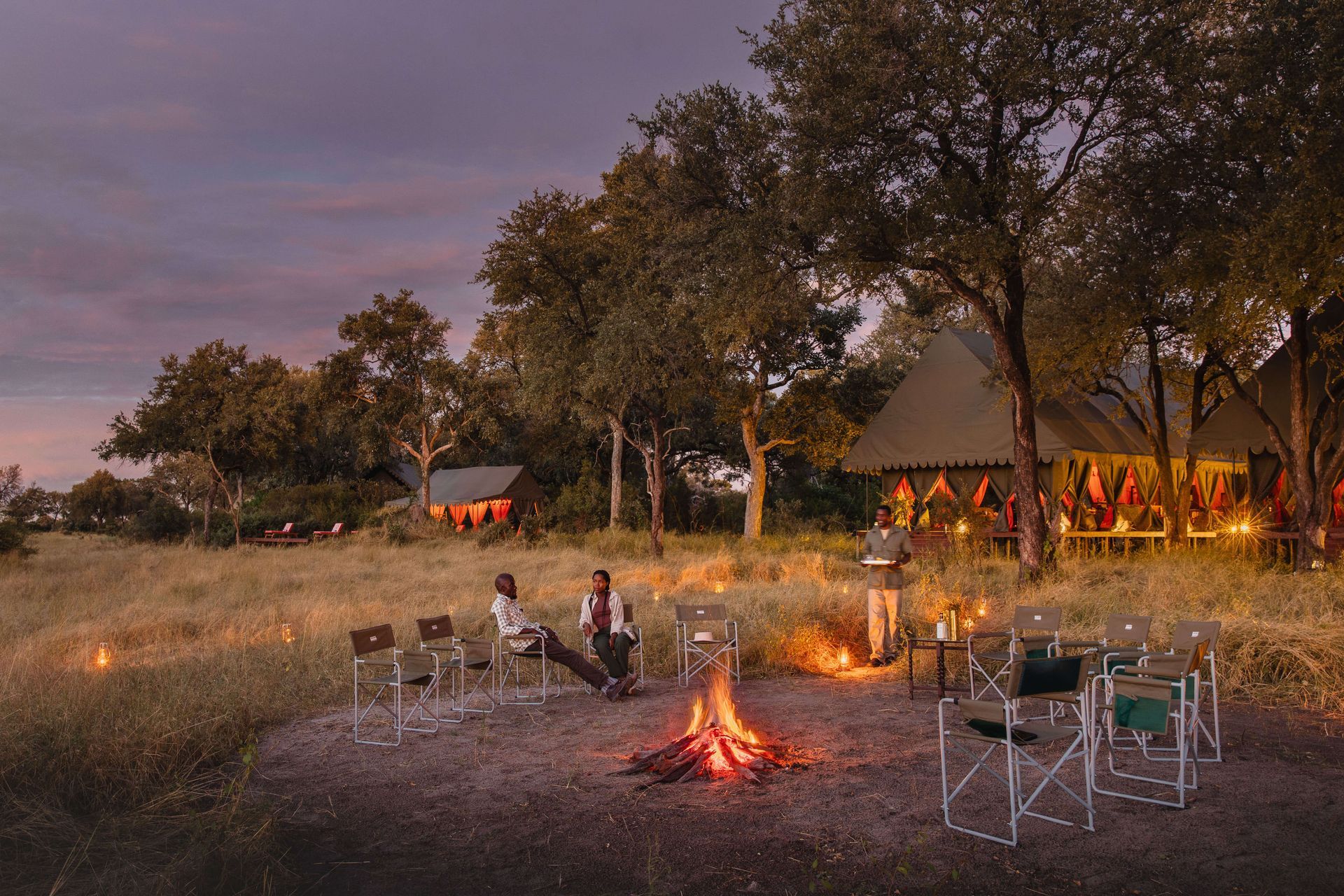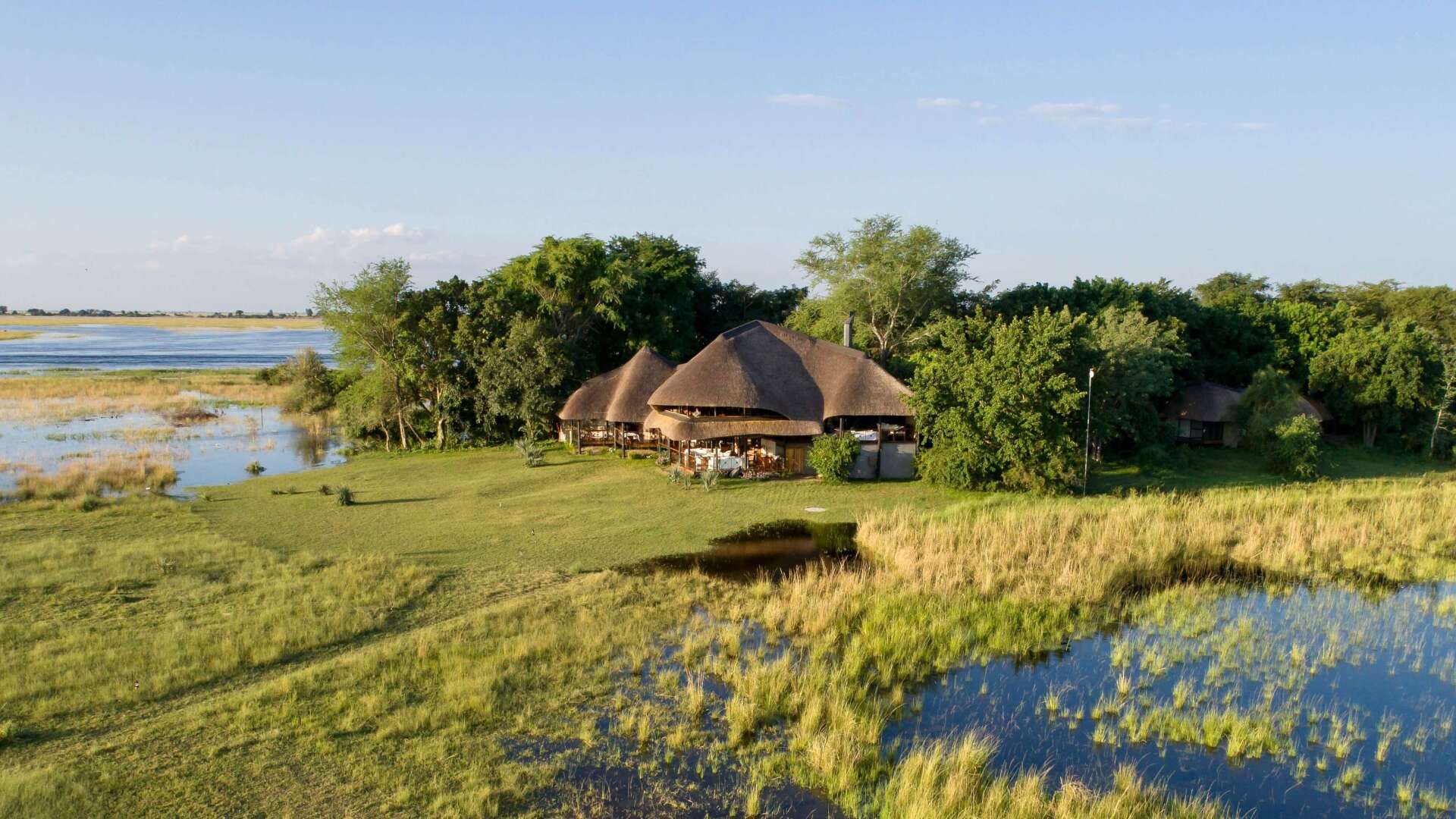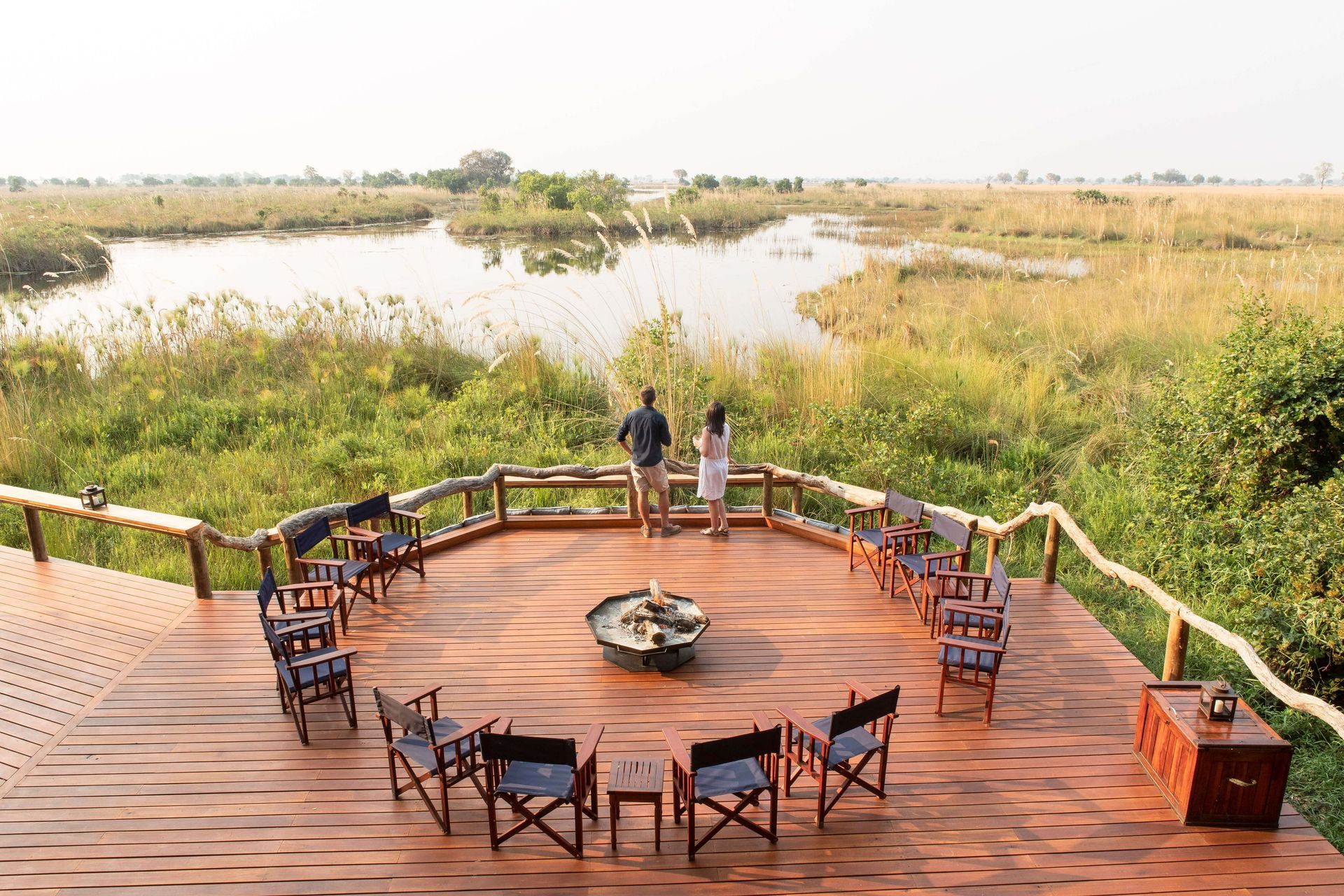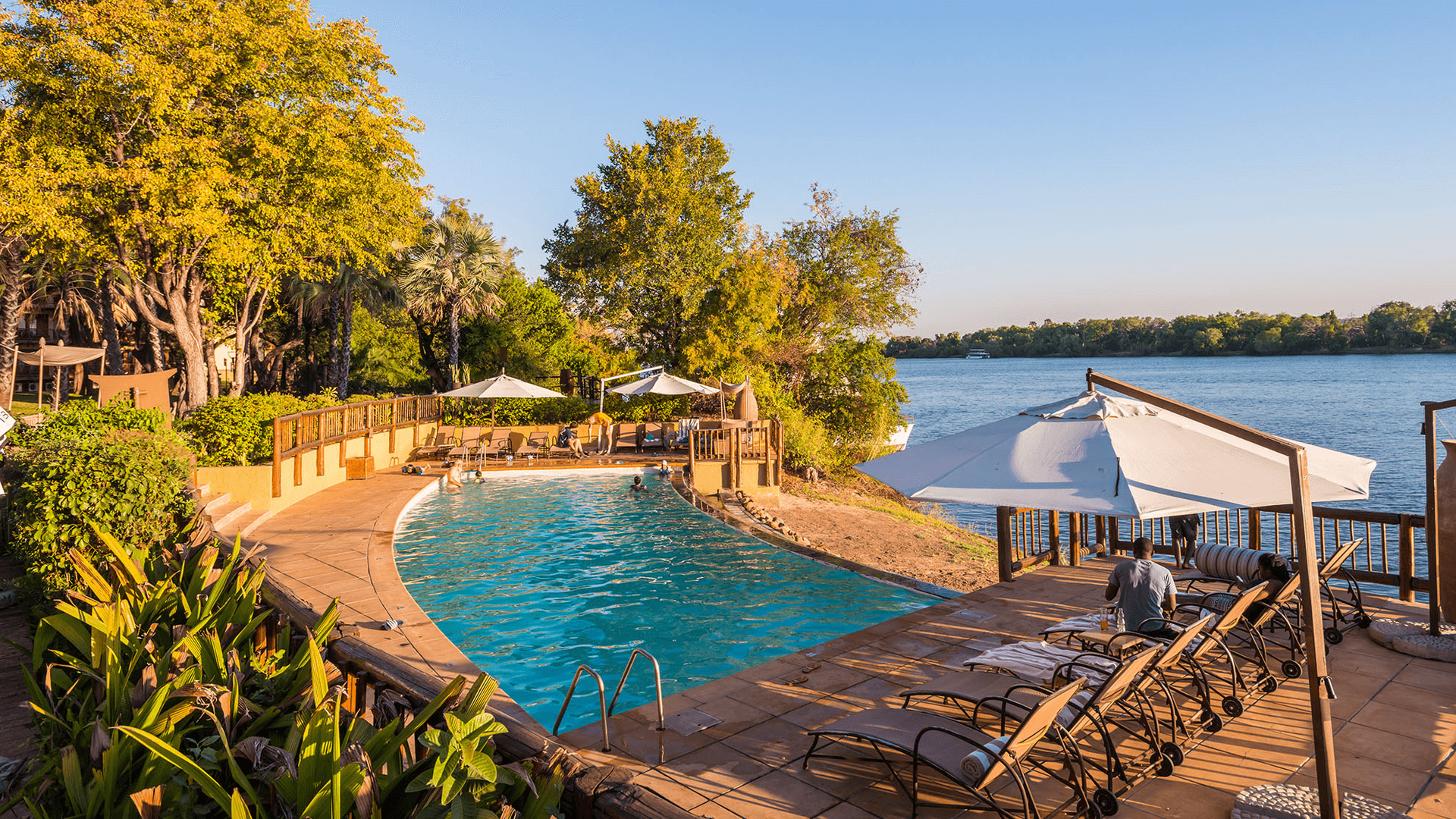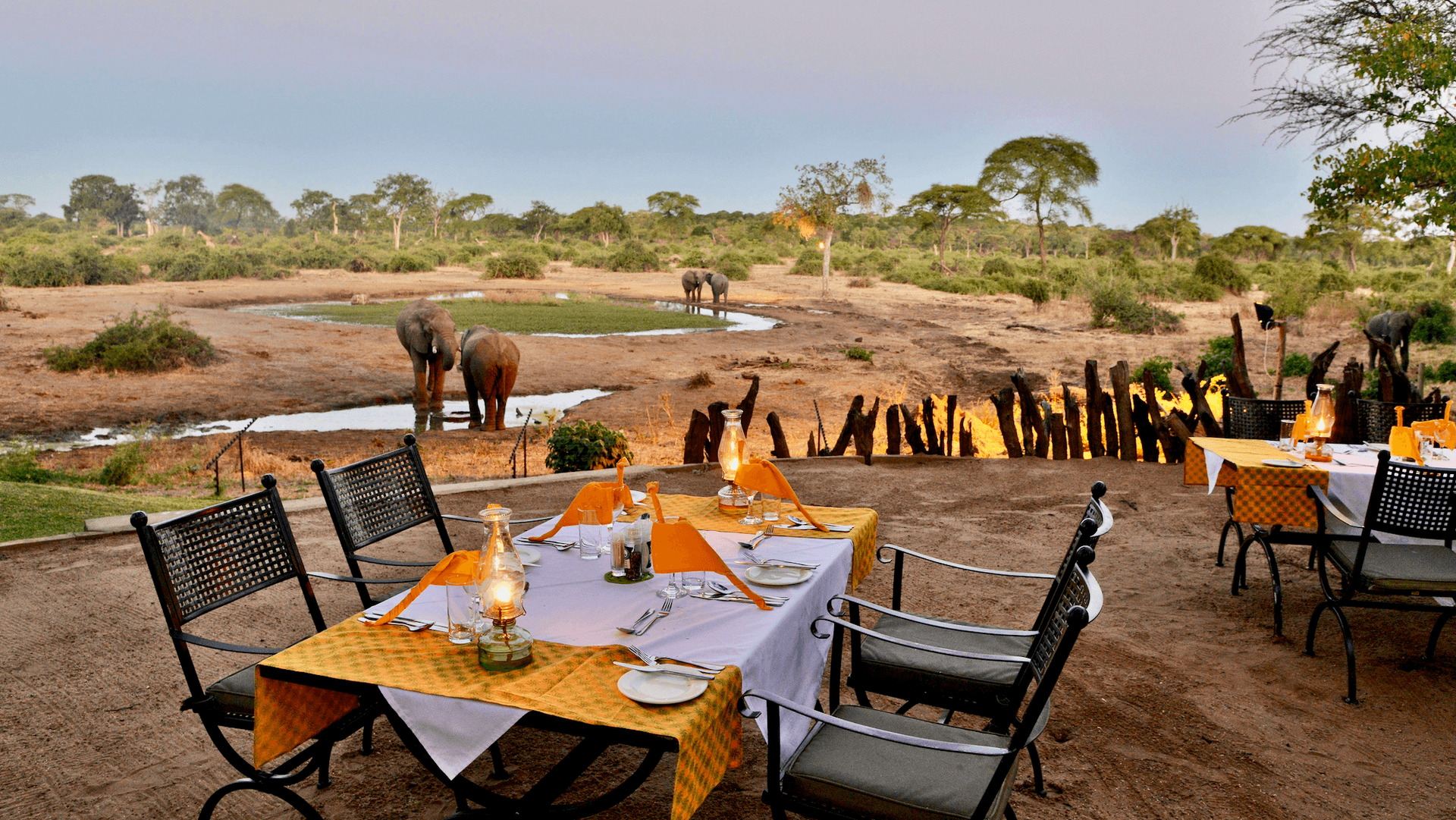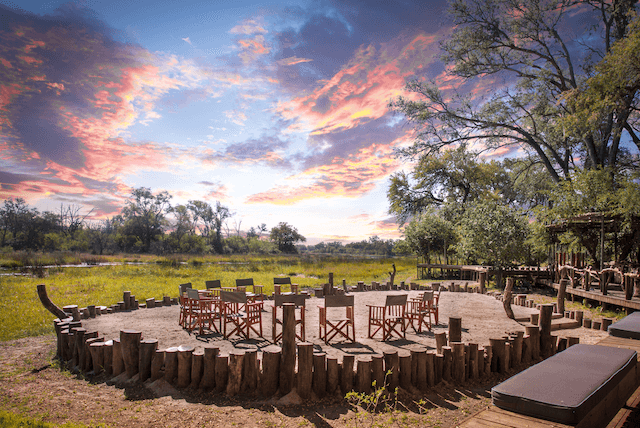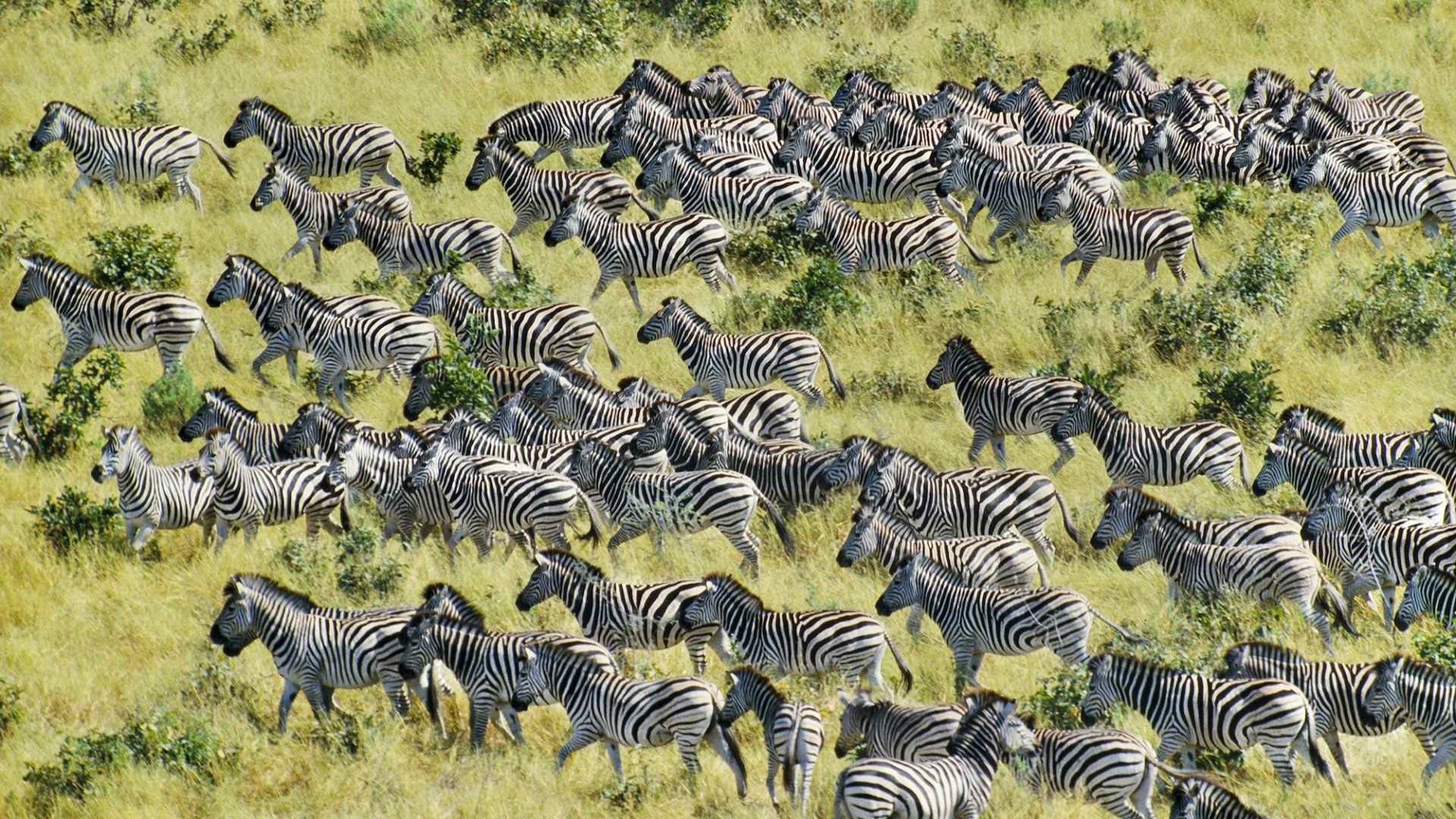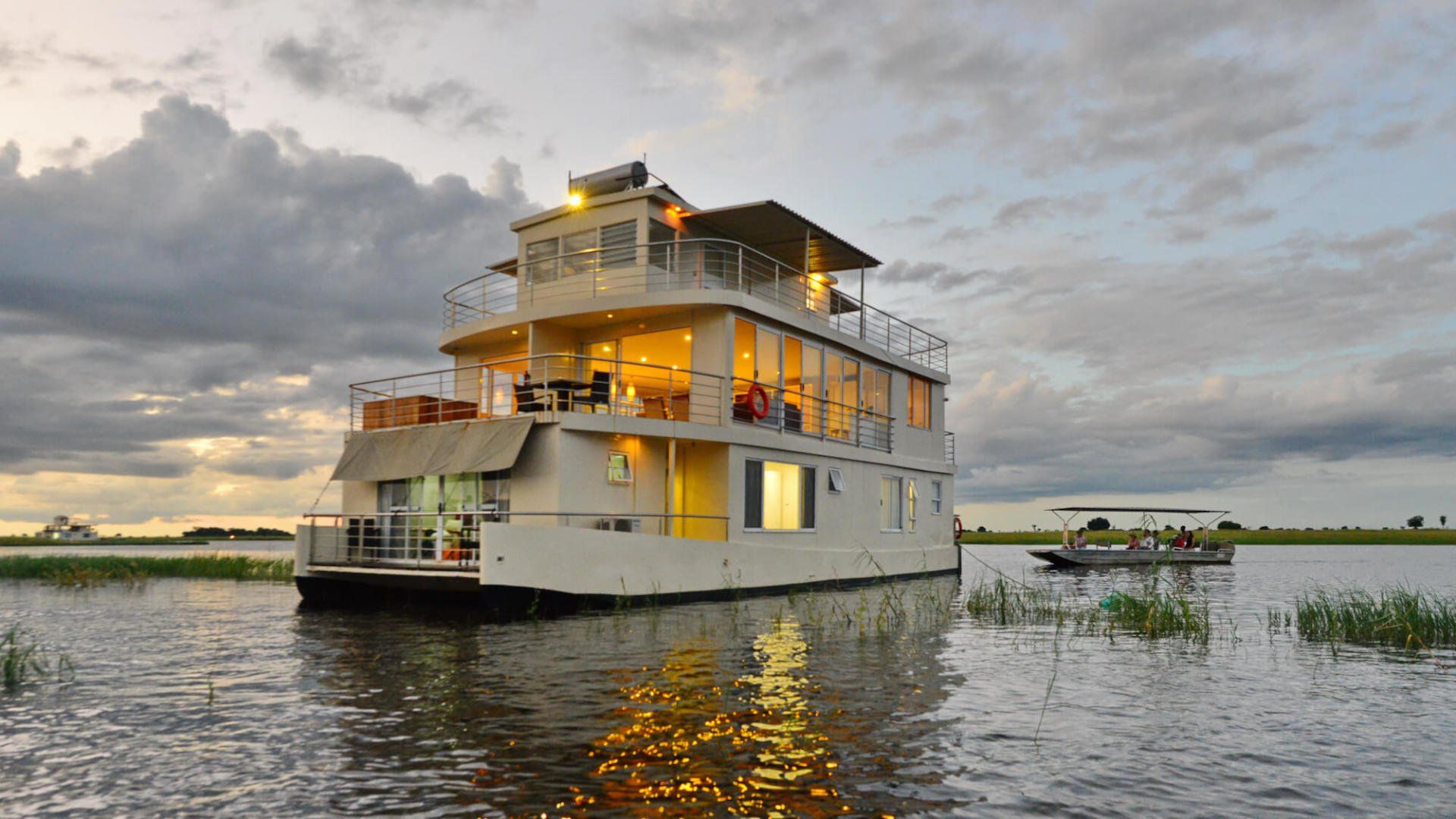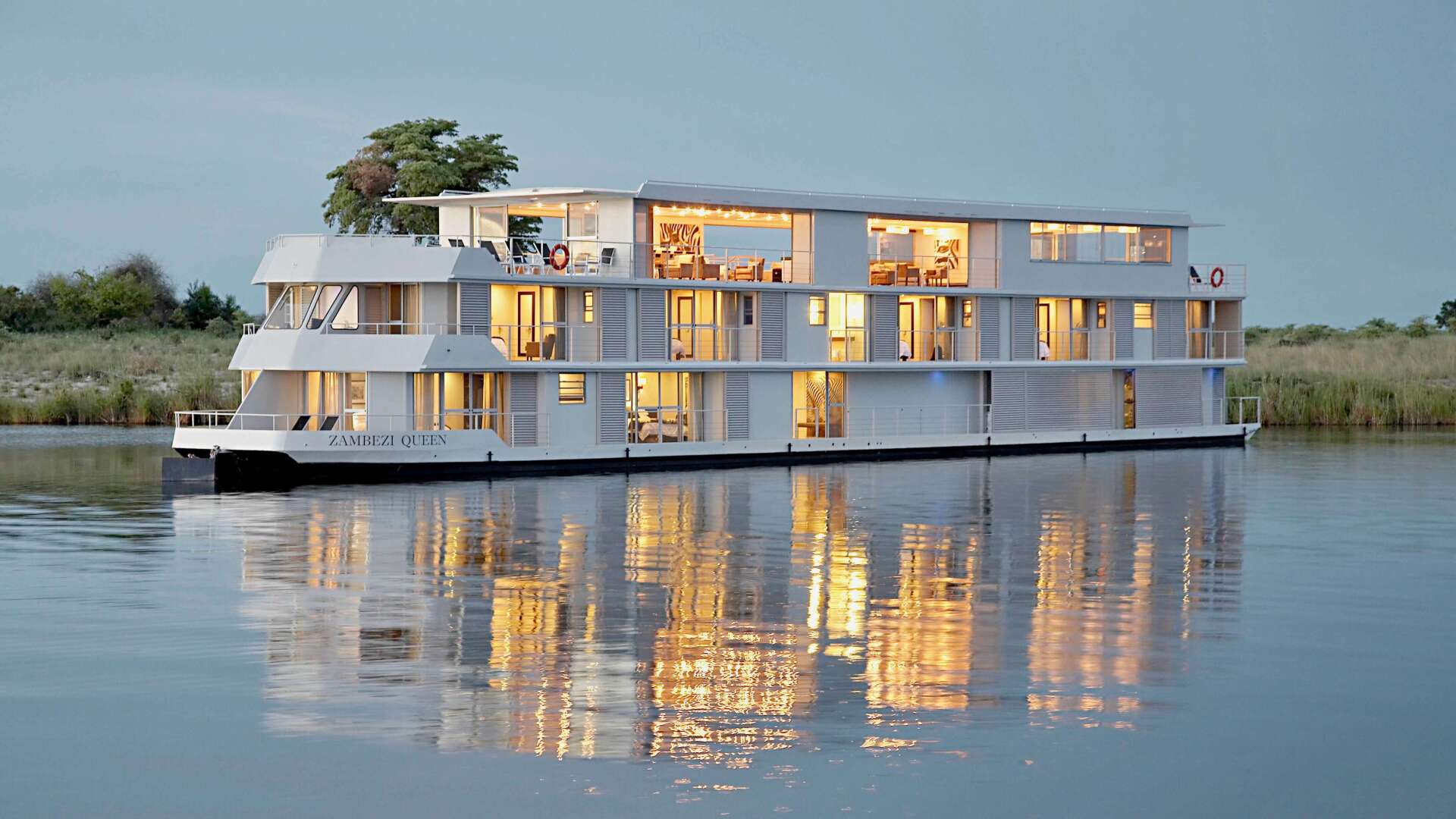Botswana National Parks
-
Chobe National Park
Brief profile:
- Covers 10,566 km²
- Wide variety of ecosystems from riverine forests, floodplains and periodic marsh to the rocky outcrops
- Over 460 bird species
Highlights:
- Huge concentration of elephants
- Boat cruise on Chobe River
- Tiger fishing on Chobe River
- High density of predators such as lions, leopards, spotted hyenas and cheetahs
Out of all of Botswanas national parks and game reserves, the Chobe National Park is the second largest national park and has one of the largest concentrations of game spotted on the African continent. Its uniqueness in the wealth of wildlife and the true African nature of the region, presents a safari experience of a lifetime. Chobe National Park is famous for its elephants. It is not uncommon to encounter herds in excess of a hundred at a time. The latest enquiry into the elephant population estimates it to be 120,000 - the highest elephant concentration in Africa and the largest continuous surviving elephant population on earth. The Chobe elephants are migratory, making seasonal movements of up to 200km from the Chobe and Linyanti rivers, where they congregate in the dry season, to the pans in the south-east of the park during the rainy season. Game viewing from the river is a spectacular showcase of the huge diversity of Chobe’s wildlife. It is hard to describe the feeling you get as you glide past hippos and crocodiles while elephants, zebras, buffaloes and even lions have an evening drink against the backdrop of a sunset sky painted in rich colours.
Over 460 bird species have been recorded in the park, making it one of Africa’s premier venues for bird safaris. Common species include the sacred ibis, Egyptian geese, the ubiquitous cormorants and darters, spur-winged geese, Pel’s fishing owl, carmine bee-eaters, most members of the kingfisher family, all the rollers, fish eagles, the martial eagle and many members of the stork family.
Best Time to Visit:
| Jan | Feb | Mar | Apr | May | Jun | Jul | Aug | Sept | Oct | Nov | Dec |
|---|---|---|---|---|---|---|---|---|---|---|---|
| Good | Good | Good | Very Good | Very Good | Very Good | Very Good | Very Good | Very Good | Very Good | Good | Good |
| Jan | Feb | Mar | Apr | May | Jun | Jul | Aug | Sept | Oct | Nov | Dec |
|---|---|---|---|---|---|---|---|---|---|---|---|
| Good | Good | Good | Very Good | Very Good | Very Good | Very Good | Very Good | Very Good | Very Good | Good | Good |
| Jan | Feb | Mar | Apr | May | Jun |
|---|---|---|---|---|---|
| Good | Good | Good | Very Good | Very Good | Very Good |
| Jul | Aug | Sept | Oct | Nov | Dec |
|---|---|---|---|---|---|
| Good | Very Good | Very Good | Very Good | Good | Good |
- Nxai Pans National Park
Brief profile:
- Covers a total area of 2578 km²
- Nxai Pan National Park is largely covered by grasslands
- More than 200 bird species have been recorded
Highlights:
- Visiting Baines Baobabs
- Zebra migration from December to March
- When flooded, the pans also offer tremendous birding and game-viewing opportunities
- Outstanding and unique landscape
Nxai Pan is one of the pans of the greater Makgadikgadi and covers around 2000 square kilometres. Much of it is covered in grass and a scattering of Acacia trees can be seen throughout the landscape. The main attraction of Nxai National Park is the Baines Baobabs, located near the salt and dry lakes of Kudiakam. These baobabs were named after the artist and explorer, Thomas Baines, who first painted them in 1862 while traveling in this deserted part of Botswana. The highlight of visiting the park is the Zebra Migration. The rich and nutritious grass in this area attracts more than 30,000 zebras and wildebeests from as far as 500km away, subesquently followed by many predators.
Nxai Pan National Park is one of the best places to experience the migration, which moves from Namibia to the Nxai Pan area, covering over 1000 kilometres. Permanent residents include the black-maned Kalahari lions, giraffes, kudus, springboks, impalas, ostriches and desert-adapted elephants (known as the “ghosts of Nxai Pan”), jackals, bat-eared foxes and numerous smaller creatures.
Best Time to Visit:
| Jan | Feb | Mar | Apr | May | Jun | Jul | Aug | Sept | Oct | Nov | Dec |
|---|---|---|---|---|---|---|---|---|---|---|---|
| Very Good | Very Good | Very Good | Good | Good | Good | Very Good | Very Good | Very Good | Good | Good | Very Good |
| Jan | Feb | Mar | Apr | May | Jun |
|---|---|---|---|---|---|
| Very Good | Very Good | Very Good | Good | Good | Good |
| Jan | Feb | Mar | Apr | May | Jun | Jul | Aug | Sept | Oct | Nov | Dec |
|---|---|---|---|---|---|---|---|---|---|---|---|
| Very Good | Very Good | Very Good | Good | Good | Good | Very Good | Very Good | Very Good | Good | Good | Very Good |
| Jul | Aug | Sept | Oct | Nov | Dec |
|---|---|---|---|---|---|
| Very Good | Very Good | Very Good | Good | Good | Excellent |
- Moremi Game Reserve
Brief profile:
- Covering 4,871 km²
- The Moremi Game Reserve is nestled within the Okavango Delta
- Over 400 bird species
- With no less than 160 mammal species
Highlights:
- Diverse habitats and abundant wildlife
- Guided walks on southern Chief’s Island
- Sightings of the rare sitatunga and lechwe antelope
- Mokoro safaris in the Delta channels
- Magnificent wildlife and sightings of rare wild dogs
The Moremi Game Reserve is situated in the eastern part of the Okavango Delta, bordering the Chobe National Park on the south-western part of the park. It covers almost one-third of the Okavango Delta, which is the largest inland river delta in the world and consists of pans, floodplains, lily-covered lagoons, grasslands, forests of acacia trees, savannahs and dense Mopane woodlands. With such a wide variety of vegetation comes a diverse spectrum of wildlife. Huge herds of impalas and tsessebe are found in the area, while in the dry season, large herds of buffaloes, wildebeests, elephants and zebras flock into the reserve from the Kalahari in search of food and water. The rare sitatunga and lechwe antelope live in the papyrus banks of the waterways. Lions, cheetahs and packs of wild dogs hunt in the open grassland. The reserve is home to over 400 species of birds, including the African fish eagle, the crested crane and the sacred ibis. This vast majoriy of mammals, birds, insects, plants, fishes and reptile species have successfully adapted to swamp conditions. Moremi Game Reserve is a wilderness paradise with great game viewing throughout the year.
The Khwai River, on the north-eastern tip of the Moremi, is an area where tall evergreen trees line a wide floodplain. It boasts an exceptionally high density and diversity of predator and prey species and leopard sightings are also consistently good here.
In the heart of Moremi lies Xakanaxa lagoon with its mopane forests and a patchwork of deep waterways and shallow flooded areas, creating a beautiful area packed with game. Leopards and cheetahs are regularly seen and the density of antelope is amazing. This area's bird life is also exceptional.
Best Time to Visit:
| Jan | Feb | Mar | Apr | May | Jun |
|---|---|---|---|---|---|
| Good | Good | Good | Good | Good | Very Good |
| Jul | Aug | Sept | Oct | Nov | Dec |
|---|---|---|---|---|---|
| Very Good | Very Good | Very Good | Very Good | Good | Good |
| Jan | Feb | Mar | Apr | May | Jun | Jul | Aug | Sept | Oct | Nov | Dec |
|---|---|---|---|---|---|---|---|---|---|---|---|
| Good | Good | Good | Good | Good | Good | Very Good | Very Good | Very Good | Very Good | Good | Good |
| Jan | Feb | Mar | Apr | May | Jun | Jul | Aug | Sept | Oct | Nov | Dec |
|---|---|---|---|---|---|---|---|---|---|---|---|
| Good | Good | Good | Good | Good | Very Good | Very Good | Very Good | Very Good | Very Good | Good | Good |
- Okavango Delta
Brief profile:
- Covering over 15,000 km²
- One of the largest and most important inland wetlands of the world
- With 2500 plant species, 65 fish species, 20 large herbivores and over 450 bird species
Highlights:
- Explore the Okavango Delta in a mokoro or with motorised boat
- Islands teeming with wildlife
- Beautiful landscapes
- Flying over the delta
- Experience peace and isolation in the heart of the Okavango Delta
The Okavango is a unique ecosystem of papyrus-lined waterways, knee-deep floodplains, water-lily lagoons, shady forest glades and rich savannah grasslands. All this lushness lies in the middle of the largest continuous stretch of sand in the world - the Kalahari Desert Basin. Seen from space as an emerald swirl surrounded by a parched landscape, the Okavango Delta is an incredible source of life in a country that is 80% arid. The Okavango region contains the Moremi Game Reserve surrounded by a number of strictly controlled, privately managed wildlife concessions. Game viewing in all of these areas is outstanding and activities can either be undertaken on foot, in a game-viewing vehicle, in a mokoro (dug-out canoe) or motorised boat. Such varied opportunities in a beautiful and diverse range of habitats, makes the Okavango the best all-encompassing safari destination in the world. The Okavango Delta is formed by the inflow of the Okavango river, (or the Kavango river as it is known in Namibia), into the arid sands of the Kalahari desert.
Best Time to Visit:
| Jan | Feb | Mar | Apr | May | Jun |
|---|---|---|---|---|---|
| Fair | Fair | Fair | Good | Good | Very Good |
| Jul | Aug | Sept | Oct | Nov | Dec |
|---|---|---|---|---|---|
| Very Good | Very Good | Very Good | Good | Fair | Fair |
| Jan | Feb | Mar | Apr | May | Jun | Jul | Aug | Sept | Oct | Nov | Dec |
|---|---|---|---|---|---|---|---|---|---|---|---|
| Fair | Fair | Fair | Good | Good | Very Good | Very Good | Very Good | Very Good | Good | Fair | Fair |
| Jan | Feb | Mar | Apr | May | Jun | Jul | Aug | Sept | Oct | Nov | Dec |
|---|---|---|---|---|---|---|---|---|---|---|---|
| Fair | Fair | Fair | Good | Good | Very Good | Very Good | Very Good | Very Good | Good | Fair | Fair |
- Central Kalahari Game Reserve
Brief profile:
- Covering 51,800 km²
- “Kalahari” is derived from the Tswana word Kgala meaning “great thirst”
- Largest game reserve in Botswana
- Over 400 identified plant species
Highlights:
- Black-maned Kalahari lion
- Bushmen interaction and cultural experiences
- Diverse desert wildlife
The Central Kalahari Game Reserve is both the largest game reserve and sand basin in the world. Situated right in the centre of Botswana, this reserve has no permanent surface water. Unlike most deserts, the Kalahari is well vegetated with a wide variety of habitats including areas of flat grasslands that seem to stretch forever. The Central Kalahari is largely vegetated with open scrubland, but also has woodland and forests with many species adapted to this harsh landscape.
In the dry winter months, many of the grasses and shrubs die back to their roots while waiting for the summer rains. Trees have developed deep roots to the water table and shrubs have leaves and pods that keep evapotranspiration to a minimum. In summer the rains transform the area and the northern section of the reserve is dotted with pans of varying sizes which fill and sustain the wildlife. The Kalahari is most beautiful in summer, particularly as many of the desert species drop their young at this time of year. Generally in the desert you do not see large herds of game, rather a variety of desert-adapted species in smaller numbers. Animals found in the region include gemsbok, springboks, hartebeests, giraffes, wildebeest, kudus, cheetahs, brown hyenas, mongeese, meerkats and the large Kalahari lions.
Best Time to Visit:
| Jan | Feb | Mar | Apr | May | Jun |
|---|---|---|---|---|---|
| Good | Very Good | Very Good | Very Good | Good | Good |
| Jul | Aug | Sept | Oct | Nov | Dec |
|---|---|---|---|---|---|
| Good | Good | Good | Good | Good | Good |
| Jan | Feb | Mar | Apr | May | Jun | Jul | Aug | Sept | Oct | Nov | Dec |
|---|---|---|---|---|---|---|---|---|---|---|---|
| Good | Very Good | Very Good | Very Good | Good | Good | Good | Good | Good | Good | Good | Good |
| Jan | Feb | Mar | Apr | May | Jun | Jul | Aug | Sept | Oct | Nov | Dec |
|---|---|---|---|---|---|---|---|---|---|---|---|
| Good | Very Good | Very Good | Very Good | Good | Good | Good | Good | Good | Good | Good | Good |
- Makgadikgadi Pans National Park
Brief profile:
- Covers an area of over 30,000 km²
- The world’s largest salt pan landscape
- Summer rains transform the arid white salt pans to lush green grazing
Highlights
- Experience the second largest wildebeest & zebra migration in Africa
- Massive baobab trees
- Quad bike trips on the salt pans
- Visit Kubu Island to see the baobabs
- Amazing stargazing experiences
- Silence and space are your companions
The Makgadikgadi Pans National Park stretches away from the banks of the Boteti River, through its interior of scrubland and grasslands. The western boundary has mineral rich grasslands and the Boteti river, which supplies the much-needed sustenance for the herds that inhabit the park. The Makgadikgadi is in fact a series of pans, the largest of which are Sowa and Ntwetwe, both surrounded by a myriad of smaller pans. The zebra and wildebeest herds graze on the rich grass plains and migrate to the river at the end of winter to access the water in the seeps. The Makgadikgadi is a harsh dry environment, suited to gemsbok and kudu, but the river provides a life-giving source of water for the zebra and wildebeest utilising the eastern grass plains. In the wet season, this reserve offers excellent wildlife viewing, particularly when large herds of zebra and wildebeest embark on their westward migration to the Boteti region. Other species include gemsbok, eland and red hartebeest, as well as kudu, bushbuck, duiker, giraffe, springbok, steenbok and even elephants, with all the accompanying predators, as well as the rare brown hyena. When there is water in the pans, thousands of flamingos, pelicans, ducks and geese congregate and the scene is indeed awe-inspiring.
One of the most popular destinations in the Makgadikgadi is Kubu Island, a rocky outcrop near the southwestern shore of Sowa pan. This crescent-shaped island is about one kilometre long and its slopes are covered with fossil beaches of rounded pebbles, an indication of the prehistoric lake’s former water levels. Fantastically shaped baobabs perch on the island and they are surrounded by the white salt surface of the pan, creating a unique otherworldly atmosphere.
Best Time to Visit:
| Jan | Feb | Mar | Apr | May | Jun |
|---|---|---|---|---|---|
| Very Good | Very Good | Very Good | Good | Good | Good |
| Jul | Aug | Sept | Oct | Nov | Dec |
|---|---|---|---|---|---|
| Very Good | Very Good | Very Good | Good | Good | Very Good |
| Jan | Feb | Mar | Apr | May | Jun | Jul | Aug | Sept | Oct | Nov | Dec |
|---|---|---|---|---|---|---|---|---|---|---|---|
| Very Good | Very Good | Very Good | Good | Good | Good | Very Good | Very Good | Very Good | Good | Good | Very Good |
| Jan | Feb | Mar | Apr | May | Jun | Jul | Aug | Sept | Oct | Nov | Dec |
|---|---|---|---|---|---|---|---|---|---|---|---|
| Very Good | Very Good | Very Good | Good | Good | Good | Very Good | Very Good | Very Good | Good | Good | Very Good |
BOTSWANA HIGHLIGHTS GROUP SAFARI
GROUP SAFARI
SA RESIDENT SPECIAL
7 days / 6 nights
Highlights: Okavango Delta - South & North Western Region
Dates: 04 - 10 March '26
BOTSWANA EXPLORER GROUP SAFARI
GROUP SAFARI
SA RESIDENT SPECIAL
7 days / 6 nights
Highlights: Khwai Private Reserve & Okavango Delta
Dates: 18 - 24 March '26
CHOBE SAVANNA LODGE GROUP SAFARI
4 days / 3 nights
Highlights: Chobe Channel
Date: Private Safari
LUXURY BOTSWANA SAFARI
SA RESIDENT SPECIAL
6 days / 5 nights
Highlights: Moremi Game Reserve & Okavango Delta
Valid until: 31 March 2025
VIC FALLS AND CHOBE SAFARI
6 days / 5 nights
Highlights: Vic Falls (Zambia) & Chobe Forest Reserve
Date: Private Safari
CHOBE - Elephant Valley Lodge
SA RESIDENT SPECIAL
4 Days / 3 Nights
Highlights: Chobe National Park
Valid until: 31 Dec 2026
HIGHLIGHTS OF BOTSWANA
6 Days / 5 Nights
Highlights: Moremi Reserve / Okavango Delta
Valid until: 31 Dec 2026
ZEBRA MIGRATION & KHWAI SAFARI
7 Days / 6 Nights
Highlights: Makgadikgadi Pans / Khwai Reserve
Date: Jan / Feb & Mar 2026
CHOBE HOUSEBOAT SAFARI
SA RESIDENT SPECIAL
4 Days / 3 Nights
Highlights: Houseboat / Chobe NP
Valid until: 28 Feb '26
ZAMBEZI QUEEN HOUSEBOAT
SA RESIDENT SPECIAL
2 OR 3 Nights
Highlights: Luxury Floating Hotel / Chobe NP
Valid until: 28 Feb '26
